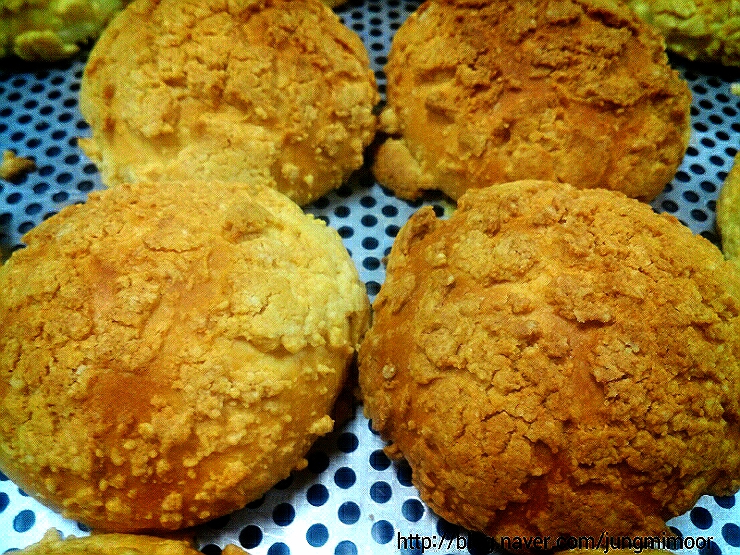Nostalgic and Delicious! Crispy & Sweet Cob Loaf (Soboro-ppang)
Cob Loaf (Soboro-ppang)

One of the breads that brings back childhood memories, the Cob Loaf (Soboro-ppang)! I remember getting scolded by my mom for only eating the crumbly topping. Here’s how to make this classic bread at home. Enjoy the delightful contrast of warm, soft bread and a wonderfully crispy, sweet topping.
Dough Ingredients- 1100g Bread Flour
- 517g Water
- 44g Fresh Yeast
- 11g Dough Improver
- 22g Salt
- 198g Margarine
- 22g Milk Powder
- 165g Eggs
- 176g Sugar
Crispy Topping (Soboro) Ingredients- 500g All-Purpose Flour
- 300g Sugar
- 250g Margarine
- 75g Peanut Butter
- 50g Eggs
- 50g Corn Syrup
- 15g Milk Powder
- 10g Baking Powder
- 5g Salt
- 500g All-Purpose Flour
- 300g Sugar
- 250g Margarine
- 75g Peanut Butter
- 50g Eggs
- 50g Corn Syrup
- 15g Milk Powder
- 10g Baking Powder
- 5g Salt
Cooking Instructions
Step 1
Let’s start with the dough. In a mixing bowl, combine all ingredients except the margarine (fat). Mix until the ‘clean-up’ stage is reached, meaning the dough starts to come together as a cohesive mass. Then, add the margarine and continue mixing until the dough is smooth and reaches the final stage of development. Once the dough is ready, place it in a bowl, cover with plastic wrap, and let it undergo its first fermentation for about 30 minutes. You’ll know it’s ready when a finger poked into the dough leaves an indentation that doesn’t spring back.

Step 2
Prepare the ingredients for the crispy Soboro topping. In a separate bowl, whisk together the all-purpose flour, milk powder, and baking powder. Sift these dry ingredients at least 2-3 times. This ensures they are well combined and will contribute to a lighter, more tender topping.

Step 3
In another bowl, combine the softened margarine, peanut butter, salt, sugar, and corn syrup. Use a whisk or spatula to mix them until well combined and creamy. Be careful not to overmix at this stage.

Step 4
Gradually add the eggs to the margarine mixture, dividing them into two additions. Beat vigorously after each addition until the sugar is dissolved and the mixture is smooth and well emulsified. Ensure the eggs are fully incorporated.

Step 5
Now, add the sifted dry ingredients (from step 1) to the bowl with the wet ingredients (from step 2 & 3). Using a spatula, gently mix the ingredients until just combined. The goal is a crumbly texture (‘pasille-pasille’ or sandy). Overmixing will result in a tough topping, so mix only until no dry flour is visible. This ‘cutting’ or ‘rubbing’ motion is key, not traditional kneading.

Step 6
Gather the crumbly Soboro dough into a mass and place it in a plastic bag. Refrigerate it to chill. Working with cold dough makes it easier to crumble and ensures a crispier baked topping.

Step 7
Check the dough after its first fermentation. If you gently poke it with a floured finger and the indentation remains without springing back, the dough has risen sufficiently.

Step 8
Divide the fermented dough into portions of approximately 46g each. Gently shape each portion into a round ball by rolling it between your palms. This smooths the surface and helps distribute the gas evenly.

Step 9
Cover the rounded dough balls with a damp cloth or plastic wrap and let them rest at room temperature for about 10 minutes for an intermediate fermentation (bench rest). This allows the gluten to relax, making the dough easier to shape.

Step 10
Remove the chilled Soboro topping dough from the refrigerator. Crumble it into small, even pieces using your hands or a tool. Aim for a consistent texture so the topping bakes evenly.

Step 11
Gently degas the rested dough balls by briefly kneading them, then shape them into rounds again. Lightly dip the top surface of each dough ball into water. This helps the Soboro topping adhere better.

Step 12
Place the wet side of the dough ball onto the crumbled Soboro topping. Gently press the topping onto the dough, focusing on the top surface. You want a good coating but not so much that it’s falling off. It’s meant to be on the top, not covering the entire ball.

Step 13
Flip the dough over. You should see the topping attached. Now, take about 26g of the crumbled Soboro topping and firmly press it onto the top of the dough ball. The final weight of the bread with topping should be around 72g (46g dough + 26g topping). Ensure the top is generously covered for that classic look and texture.

Step 14
Place the topped dough balls onto a baking sheet, leaving some space between them. Cover with plastic wrap or a damp cloth for the second fermentation, which should take about 30 minutes. The dough should increase in size by about 1.5 times. A warm, humid environment is ideal.

Step 15
Once the second fermentation is complete, bake the Soboro-ppang in a preheated oven at the specified temperature for 12-15 minutes, or until the topping is golden brown and crispy. Keep an eye on them as oven temperatures can vary. Enjoy your delicious homemade Soboro-ppang while warm!




